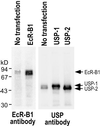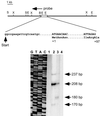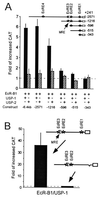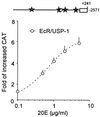Activation of a delayed-early gene encoding MHR3 by the ecdysone receptor heterodimer EcR-B1-USP-1 but not by EcR-B1-USP-2
- PMID: 10373539
- PMCID: PMC84291
- DOI: 10.1128/MCB.19.7.4897
Activation of a delayed-early gene encoding MHR3 by the ecdysone receptor heterodimer EcR-B1-USP-1 but not by EcR-B1-USP-2
Abstract
MHR3, a homolog of the retinoid orphan receptor (ROR), is a transcription factor in the nuclear hormone receptor family that is induced by 20-hydroxyecdysone (20E) in the epidermis of the tobacco hornworm, Manduca sexta. Its 2.7-kb 5' flanking region was found to contain four putative ecdysone receptor response elements (EcREs) and a monomeric (GGGTCA) nuclear receptor binding site. Activation of this promoter fused to a chloramphenicol acetyltransferase (CAT) reporter by 2 micrograms of 20E per ml in Manduca GV1 cells was similar to that of endogenous MHR3, with detectable CAT by 3 h. When the ecdysone receptor B1 (EcR-B1) and Ultraspiracle 1 (USP-1) were expressed at high levels under the control of a constitutive promoter, CAT levels after a 3-h exposure to 20E increased two- to sixfold. In contrast, high expression of EcR-B1 and USP-2 caused little increase in CAT levels in response to 20E. Moreover, expression of USP-2 prevented activation by EcR-B1-USP-1. Deletion experiments showed that the upstream region, including the three most proximal putative EcREs, was responsible for most of the 20E activation, with the EcRE3 at -671 and the adjacent GGGTCA being most critical. The EcRE1 at -342 was necessary but not sufficient for the activational response but was the only one of the three putative EcREs to bind the EcR-B1-USP-1 complex in gel mobility shift assays and was responsible for the silencing action of EcR-B1-USP-1 in the absence of hormone. EcRE2 and EcRE3 each specifically bound other protein(s) in the cell extract, but not EcR and USP, and so are not EcREs in this cellular context. When cell extracts were used, the EcR-B1-USP-2 heterodimer showed no binding to EcRE1, and the presence of excess USP-2 prevented the binding of EcR-B1-USP-1 to this element. In contrast, in vitro-transcribed-translated USP-1 and USP-2 both formed heterodimeric complexes with EcR-B1 that bound ponasterone A with the same Kd (7 x 10(-10) M) and bound to both EcRE1 and heat shock protein 27 EcRE. Thus, factors present in the cell extract appear to modulate the differential actions of the two USP isoforms.
Figures





 ), 3 (▧), or 6 (■) h over the uninduced
level at 0 h (set at 1). The deletion constructs tested are
shown in the map above. Stars, putative EcRE; open circle, GGGTCA
sequence. Means ± standard deviations (error bars) are shown
(n = 3).
), 3 (▧), or 6 (■) h over the uninduced
level at 0 h (set at 1). The deletion constructs tested are
shown in the map above. Stars, putative EcRE; open circle, GGGTCA
sequence. Means ± standard deviations (error bars) are shown
(n = 3).



References
-
- Asahina M, Jindra M, Riddiford L M. Developmental expression of Ultraspiracle proteins in the epidermis of the tobacco hornworm, Manduca sexta, during larval life and the onset of metamorphosis. Dev Genes Evol. 1997;20:381–388. - PubMed
-
- Ausubel F M, Brent R, Kingston R E, Moore D D, Seidman J G, Smith J A, Struhl K, editors. Current protocols in molecular biology, vol. 1, section 4.8. New York, N.Y: John Wiley & Sons; 1994.
-
- Burtis K C, Thummel C S, Jones W C, Karim F D, Hogness D S. The Drosophila E74 early puff contains E74, a complex ecdysone-inducible gene that encodes two ets-related proteins. Cell. 1990;61:85–90. - PubMed
-
- Cherbas L, Cherbas P. The arthropod initiator: the capsite consensus plays an important role in transcription. Insect Biochem Mol Biol. 1993;23:81–90. - PubMed
Publication types
MeSH terms
Substances
Associated data
- Actions
Grants and funding
LinkOut - more resources
Full Text Sources
Molecular Biology Databases
Miscellaneous
